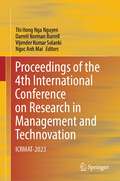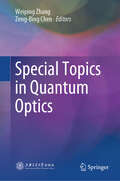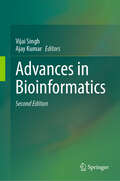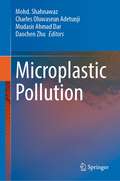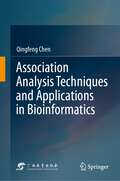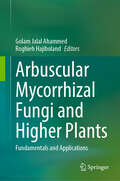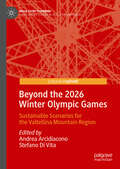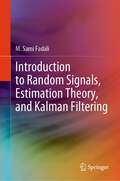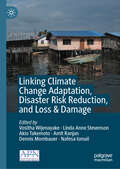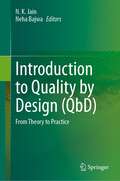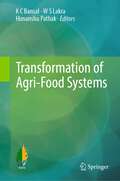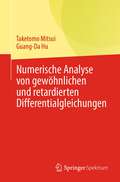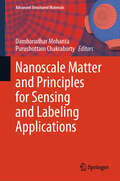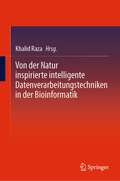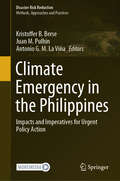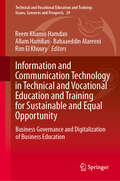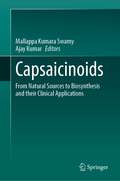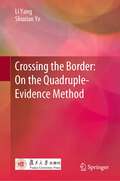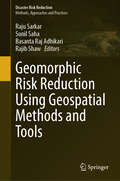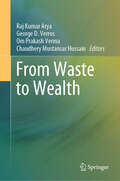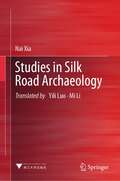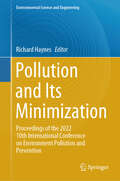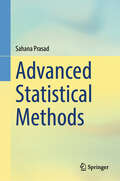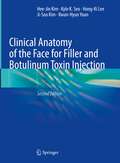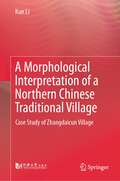- Table View
- List View
Proceedings of the 4th International Conference on Research in Management and Technovation: ICRMAT-2023
by Thi Hong Nga Nguyen Darrell Norman Burrell Vijender Kumar Solanki Ngoc Anh MaiThis book brings together selected papers from the Fourth International Conference on Research in Management and Technovation held in Hanoi, Vietnam, in 2023, with a focus on defining action-based plans around innovation and technology as tools for societal and organizational advancement. Today's business and technology intersections are obvious. Cloud-sharing, scheduling, and virtual conference rooms are some of the few examples. Cutting-edge academic researchers use business and technology every day to navigate volatility, uncertainty, complexity, and ambiguity (VUCA) in the environment, make good judgments, stay ahead of the competition, better their marketing tactics, and create new business initiatives. The research highlighted in this book aims to demonstrate how technology empowers managers, strategists, and researchers to make decisions that are data-driven and effective.
Special Topics in Quantum Optics
by Weiping Zhang Zeng-Bing ChenThis book highlights quantum optics technologies that can revolutionize the way we encode, store, transmit, and handle information. These technologies can help us overcome bottlenecks in classical physics-based information technology in information transmission capacity, computing speed, and information security. The book provides readers with new perspectives on potential applications of the quantum theory. Besides, the book summaries the research advances in quantum optics and atom optics, including manipulation and construction of the quantum states of photons and even atoms, molecules, and matter at the quantum level, and new phenomena and technologies brought about by the interactions between photons and the quantum states of matter. The book provides extensive and thoroughly exhaustive coverage of quantum optics. It is suitable for researchers and graduate students of optical physics and quantum optics.
Advances in Bioinformatics
by Vijai Singh Ajay KumarThe second edition of Advances in Bioinformatics presents the latest developments in bioinformatics in gene discovery, genome analysis, genomics, transcriptomics, proteomics, metabolomics, metabolic flux analysis, drug discovery, and drug repurposing. It includes advancements in the applications of bioinformatics in the analysis of non-coding RNA, next-generation sequencing, genome-scale modelling, high throughput drug screening, precision medicine, automation and artificial intelligence, and machine learning. The chapter also summarizes the technologies and concepts that form the basis of this functional genomics approach. Additionally, the book highlights some of the areas in which bioinformatics resources and methods are being developed to support the drug discovery pipeline. The chapter also discusses the role of bioinformatics in modelling and simulations of molecular biology systems in pathways identification and design. It is a valuable source of information for beginners in bioinformatics and students, researchers, scientists, clinicians, practitioners, policymakers, and stakeholders who are interested in harnessing the potential of bioinformatics in biomedical and allied sciences.
Microplastic Pollution
by Mohd. Shahnawaz Charles Oluwaseun Adetunji Mudasir Ahmad Dar Daochen ZhuThis edited volume covers cutting-edge research on different facets of microplastic pollution at the global level. The book describes different types of microplastics, their sources, transportation, extraction, identification, deleterious effects (on flora and fauna) and various mitigation measures. This book discusses recent advances in microplastic pollution and suggests future research directions to mitigate microplastic at the global level. It constitutes six important sections to report different facets of microplastic pollution. Section 1 deals with microplastic types, sources, uses and transport from land to aquatic environment; Section 2 reports detection, collections, extraction and identification of different types of microplastic from various polluting sites; Section 3 suggests cleaning drives for the removal of microplastic from the polluting sites; Section 4 highlights the impact of microplastic waste on flora and fauna in both terrestrial and aquatic environments; Section 5 enlists various microplastic degradation approaches to mitigate microplastic; and Section 6 discusses recent regulations/policies to minimize microplastic generation, followed by future research directions to mitigate microplastic pollution at global level. This book is of interest and useful to professionals working on microplastic mitigation, environment protection and waste management, NGOs and policymakers.
Association Analysis Techniques and Applications in Bioinformatics
by Qingfeng ChenAdvances in experimental technologies have given rise to tremendous amounts of biology data. This not only offers valuable sources of data to help understand biological evolution and functional mechanisms, but also poses challenges for accurate and effective data analysis. This book offers an essential introduction to the theoretical and practical aspects of association analysis, including data pre-processing, data mining methods/algorithms, and tools that are widely applied for computational biology. It covers significant recent advances in the field, both foundational and application-oriented, helping readers understand the basic principles and emerging techniques used to discover interesting association patterns in diverse and heterogeneous biology data, such as structure-function correlations, and complex networks with gene/protein regulation. The main results and approaches are described in an easy-to-follow way and accompanied by sufficientreferences and suggestions for future research. This carefully edited monograph is intended to provide investigators in the fields of data mining, machine learning, artificial intelligence, and bioinformatics with a profound guide to the role of association analysis in computational biology. It is also very useful as a general source of information on association analysis, and as an overall accompanying course book and self-study material for graduate students and researchers in both computer science and bioinformatics.
Arbuscular Mycorrhizal Fungi and Higher Plants: Fundamentals and Applications
by Golam Jalal Ahammed Roghieh HajibolandThis book covers the fundamentals of arbuscular mycorrhizal fungi (AMF) and higher plant symbiosis with potential implications in crop production. It provides new insights into our understanding of the mechanisms of AMF-mediated plant growth regulation and stress tolerance covering the most recent biochemical, physiological, molecular, environmental, and ecological studies. Focusing on AMF-induced physiological and molecular mechanisms of enhanced tolerance to stress, environmental stress is discussed in several dedicated chapters. The book provides not only updated information with new insights and perspectives but also several new topics, such as a comprehensive discussion on biotic stressors, AMF interaction with other microorganisms, non-host plant species, plant secondary metabolism, signaling events in plant-AMF symbiosis, AMF-mediated nutrient acquisition and subsequent stress tolerance. The book also discusses the potential implications of AMF for sustainable crop production inthe context of climate change. The book can be a useful reference book for academics and scientists involved in related research, such as academics in agronomy and plant sciences, scientists involved in beneficial fungi research, chemists, industrialists, and employees involved in the production and marketing of biofertilizers, master and doctoral degree students of agronomy, horticulture, and plant protection, consultants working on the production of crops in marginal environments as well as environmental scientists working for assisted phytoremediation programs. It would also be suitable for agronomy, ecology, and plant science-related courses, such as plant stress physiology, plant growth-promoting microbes, and plant pathology to teach undergraduate, graduate, and postgraduate students at colleges and universities.
Beyond the 2026 Winter Olympic Games: Sustainable Scenarios for the Valtellina Mountain Region (Mega Event Planning)
by Andrea Arcidiacono Stefano Di VitaThis volume offers a novel study of the Milan-Cortina's Winter Olympics 2026, with a focus on the mountainous region of Valtellina. It brings an up-to-date analysis of the complex interactions between mega-events and remote areas, both in terms of potentials for regeneration and risks for further segregation. Remote areas are traditionally characterized by socio-economic and spatial disparities. On the one hand, they benefit from attractive features, such as environmental and landscape resources, food and wine production, and energy production. On the other, they are by definition fragile environments, disrupted by the contradictions of international tourism, climate change, limited infrastructures and services, rural abandonment, and demographic decline.This book offers credible solutions for the sustainable development of mountainous regions as a legacy of Winter Olympics. It is an essential resource for scholars, professionals, and policy-makers in the fieldsof urban planning and design, architecture design, geography, sociology, and economics.
Introduction to Random Signals, Estimation Theory, and Kalman Filtering
by M. Sami FadaliThis book provides first-year graduate engineering students and practicing engineers with a solid introduction to random signals and estimation. It includes a statistical background that is often omitted in other textbooks but is essential for a clear understanding of estimators and their properties. The book emphasizes applicability rather than mathematical theory. It includes many examples and exercises to demonstrate and learn the theory that makes extensive use of MATLAB and its toolboxes. Although there are several excellent books on random signals and Kalman filtering, this book fulfills the need for a book that is suitable for a single-semester course that covers both random signals and Kalman filters and is used for a two-semester course for students that need remedial background. For students interested in more advanced studies in the area, the book provides a bridge between typical undergraduate engineering education and more advanced graduate-level courses.
Linking Climate Change Adaptation, Disaster Risk Reduction, and Loss & Damage (Sustainable Development Goals Ser.)
by Linda Anne Stevenson Amit Ranjan Dennis Mombauer Vositha Wijenayake Akio Takemoto Nafesa IsmailThis book advances knowledge on loss & damage (L&D) and its interlinkages with climate adaptation and disaster risk reduction. The book includes twelve case studies conducted across South and Southeast Asia, covering sectors including agriculture, rural livelihoods, energy, infrastructure and natural resources. These studies provide insights into complex climate-induced L&D, enhancing local, national and regional knowledge and contributing to global agendas.
Introduction to Quality by Design (QbD): From Theory to Practice
by N. K. Jain Neha BajwaThis book offers a comprehensive exploration of the Quality by Design (QbD) methodology, guiding readers from theory to practical application with accessible examples. It equips readers with both foundational and advanced knowledge, emphasizing the critical parameters necessary for designing pharmaceutical products that meet the highest quality standards. The book goes beyond theory to demonstrate how to effectively implement QbD principles in various aspects of pharmaceutical research and development, including analytical methods, formulation, and packaging processes. Through a step-by-step approach, it prepares researchers in pharmaceutical sciences, as well as professionals in the pharmaceutical and healthcare industries (including suppliers), to successfully integrate QbD into their work.
Transformation of Agri-Food Systems
by K. C. Bansal W. S. Lakra Himanshu PathakThis edited volume covers all major topics related to agri-food transformation towards sustainability in this era of climate change. The topics cover field crops, horticultural crops, livestock sector, nutritional aspects, application of latest field-based technologies, and agriculture related policies and institutions.Some of the key topics are: Innovations for Reconfiguring Food Systems; Transforming High-value Food Commodities; Demand-Supply of Agri-food Commodities; Balancing Human Demand and Ecological Sustainability; International Partnership for Transformation of Agri-Food Systems; Transforming Animal Health and Aquatic Food Systems for Food Security; Climate Resilient Agriculture; Addressing Nutritional Security through Natural Resource Management; Water Harvesting and Improving Water Productivity; Combating Micronutrient Deficiencies; Plant Genetic Resources for Food Security and Nutrition; Genome Editing for Crop Improvement; and Biosafety and Socioeconomic Considerations.Written by experts, this book serves in exchanging and sharing the latest research findings, ideas and experiences on all aspects of agri-food systems to enable the formulation of the ways forward to transform our agri-food system to meet the Sustainable Development Goals (SDGs) of the United Nations by 2030. The target audience include academicians, researchers, students, farmers, entrepreneurs, policy makers, and others.
Numerische Analyse von gewöhnlichen und retardierten Differentialgleichungen
by Taketomo Mitsui Guang-Da HuDieses Buch dient als prägnantes Lehrbuch für Studenten in einem fortgeschrittenen Undergraduate- oder First-Year-Graduate-Kurs in verschiedenen Disziplinen wie angewandte Mathematik, Steuerung und Ingenieurwesen, die den modernen Standard der numerischen Methoden von gewöhnlichen und verzögerten Differentialgleichungen verstehen wollen. Experten in denselben Bereichen können sich auch über die jüngsten Entwicklungen in der numerischen Analyse solcher Differentialsysteme informieren. Gewöhnliche Differentialgleichungen (ODEs) sind ein starkes mathematisches Werkzeug, um eine Vielzahl von Phänomenen in Wissenschaft und Technik auszudrücken. Neben ihrer eigenen Bedeutung ist eine der mächtigen Richtungen, in die sich ODEs ausdehnen, die Einbeziehung einer unbekannten Funktion mit verzögertem Argument. Dies wird als verzögerte Differentialgleichungen (Delay differential equations, DDEs) bezeichnet, die häufig in der mathematischen Modellierung vonBiologie, Demographie, Epidemiologie und Kontrolltheorie vorkommen. In einigen Fällen kann die Lösung einer Differentialgleichung durch algebraische Kombinationen bekannter mathematischer Funktionen erhalten werden. In vielen praktischen Fällen ist eine solche Lösung jedoch recht schwierig oder nicht verfügbar, und es sind numerische Näherungen erforderlich. Die moderne Entwicklung von Computern beschleunigt die Situation und eröffnet darüber hinaus mehr Möglichkeiten der numerischen Mittel. Die Kenntnis und das Fachwissen über die numerische Lösung von Differentialgleichungen wird nun in weiten Bereichen der Wissenschaft und des Ingenieurwesens vorausgesetzt.Man könnte meinen, dass ein gut organisiertes Softwarepaket wie MATLAB in etwa die gleiche Lösung bietet. In gewisser Weise stimmt das auch, aber man muss bedenken, dass der blinde Einsatz von Softwarepaketen den Benutzer in die Irre führt. Das Wesentliche der numerischen Lösung von Differentialgleichungen muss noch gelernt werden. Das vorliegende Buch soll das Wesentliche der numerischen Lösungen von gewöhnlichen Differentialgleichungen sowie von Verzögerungsdifferentialgleichungen vermitteln. Die Autoren haben insbesondere festgestellt, dass es noch wenige prägnante Lehrbücher über Verzögerungsdifferentialgleichungen gibt, und haben sich dann daran gemacht, die Lücke durch möglichst transparente Beschreibungen zu schließen. Die wichtigsten Algorithmen zur numerischen Lösung sind in diesem Buch klar beschrieben. Auch die Stabilität von Lösungen von ODEs und DDEs ist von entscheidender Bedeutung. Das Buch führt in die asymptotische Stabilität von analytischen und numerischen Lösungen ein und bietet einen praktischen Weg zur Analyse ihrer Stabilität unter Verwendung einer Theorie komplexer Funktionen.
Nanoscale Matter and Principles for Sensing and Labeling Applications (Advanced Structured Materials #206)
by Dambarudhar Mohanta Purushottam ChakrabortyThis book is a compilation of carefully chosen chapters that cover the subjects of nanoscale matter, sensing, and labelling applications. It is aimed primarily at scientists and researchers who are already involved in theme-based research or who are just starting their careers. Despite the diverse nature of the topics covered, which include a range of materials in various forms and uses, the emphasis is primarily on sensing and labelling phenomena. The book begins with materials quantification in nanoscale systems by using an innovative technique like “molecular secondary ion mass spectrometry without calibration standards”. Subsequently, the book features an array of materials such as inorganic semiconductor nanoscale particles, carbon dots, rare-earth oxides, polymer nanocomposites, and a few biomaterials, all of which illustrate their functionality and potential for deployment in a wide variety of sensing applications. Although the book delves into the technical aspects of fabrication workouts to some extent, the focus is predominantly on the physical principles, mechanisms, and relevance involved in sensing and labelling applications. The book covers a wide range of topics that leverage the unique properties of nanoscale materials. By carefully selecting appropriate active materials, the authors explore the detection of LPG, hazardous and explosive gases, as well as humidity sensing and hydrogen evolution. It also delves into photo-sensing and persistent photoconductivity by using nanoscale semiconductors, which are used for heavy metal sensing and UV sensing, respectively. The use of metal nanoparticles in various forms is reviewed to address issues related to water contamination, biofilm protection, and food-borne pathogens. The book also discusses surface plasmon resonance, starting with its basic principles and expanding to its relevance in a broader perspective, with a greater focus on applied biosensing. Nanoscale ferrites and magnetic systems are explored with an emphasis on magnetic sensing and actuation. Lastly, the book explores the use of rare-earth-based nanosystems, highlighting persistent luminescence and up/down-converted transitions, which have unprecedented applications in bioimaging and biolabeling. Every effort has been made to strike a balance between the observed phenomena in the emerging areas of sensing applications and suitable theoretical treatments there in.
Von der Natur inspirierte intelligente Datenverarbeitungstechniken in der Bioinformatik
by Khalid RazaDieses Buch umfasst und beschäftigt sich mit den jüngsten Fortschritten und modernsten Anwendungen von naturinspirierten Computertechniken (NIC) im Bereich der Bioinformatik und der Computerbiologie, die die medizinischen Wissenschaften bei verschiedenen klinischen Anwendungen unterstützen können. Dieser Sammelband befasst sich mit den grundlegenden Anwendungen, dem Umfang und den Zukunftsperspektiven von NIC-Techniken in der Bioinformatik, einschließlich der Erstellung von Genomprofilen, der Klassifizierung von Genexpressionsdaten, der DNA-Berechnung, der System- und Netzwerkbiologie, der Lösung von Komplikationen bei personalisierten Therapien, der antimikrobiellen Resistenz bei bakteriellen Krankheitserregern und der computergestützten Entwicklung von Arzneimitteln, deren Entdeckung und Therapie. Darüber hinaus wird die Rolle von NIC-Techniken bei verschiedenen Krankheiten und Störungen behandelt, einschließlich Krebserkennung und -diagnose, Brustkrebs, Erkennung von Lungenkrankheiten, Krankheits-Biomarkern und Identifizierung potenzieller Therapeutika.
Climate Emergency in the Philippines: Impacts and Imperatives for Urgent Policy Action (Disaster Risk Reduction)
by Kristoffer B. Berse Juan M. Pulhin Antonio G. M. La ViñaThis book provides a snapshot of the manifestations of the climate emergency in the Philippines from a wide array of disciplines including physical sciences, social sciences, arts and humanities, management, and law. Researchers and faculties at the University of the Philippines contributed to this compilation, where each chapter provides policymakers and the public a clear picture of why climate change must be confronted with a sense of urgency and near-desperation.Divided into three main parts, the first one zeroes in on climate-vulnerable sectors such as water, food and agriculture, health, and coastal communities in the Philippines to introduce readers to the current pressing impacts of the climate emergency. The second part presents case studies of local experiences from the country’s three island regions, namely, Luzon, Visayas, and Mindanao, and it situates the readers in different environments and contexts. The third part features transdisciplinary responses to the climate emergency, including salient challenges in relation to planning, financing, communication, and education. The concluding chapter highlights eight areas for action to tackle the climate emergency. Each chapter comes with an overview and a Summary for Policymakers, which provides clear guidance for action to be taken by both local and national policymakers.
Information and Communication Technology in Technical and Vocational Education and Training for Sustainable and Equal Opportunity: Business Governance and Digitalization of Business Education (Technical and Vocational Education and Training: Issues, Concerns and Prospects #39)
by Reem Khamis Hamdan Allam Hamdan Bahaaeddin Alareeni Rim El KhouryThis book provides an in-depth analysis of current development concerning ICTs with reference to vocational education and training. It presents the best and innovative ICT-based solutions implemented in education and explores controversial topics such as challenges and opportunities. Information and communication technologies (ICTs) have dramatically changed the way we learn and work. They have created new opportunities along with new challenges, putting profound and urgent implications on vocational education and training (VET). Nowadays, we must think broadly and make the right choices about VET using innovation and digitalization to boost the quality of vocational education and training, enable the upskilling and reskilling of adults, and enhance the employability of learners. The potential and the impact of ICTs in vocational education and training have yet to be fully exploited, leading to an emerging direction of research. This book helps readers to understand the idea of business education and education governance in a digital age. It is of interest to practitioners, administrators, researchers, teachers, teacher educators and students.
Capsaicinoids: From Natural Sources to Biosynthesis and their Clinical Applications
by Mallappa Kumara Swamy Ajay KumarThis edited book brings out a comprehensive collection of information on capsaicinoids. Primarily, this book includes compiled knowledge on various aspects of capsaicin from ethnobotany to the most important clinical applications. This book covers topics emphasizing chemistry, biosynthesis, anticancer activities, bioavailability, currently undergoing experimental phases, and biotechnological methods, including cell cultures, and metabolic engineering in heterologous microbial and plant systems to enhance capsaicin production. Capsaicinoids are a group of important compounds that are particularly synthesized by various members of the genus Capsicum in their placenta. Capsaicin is the most abundant vanilloid compound among the different capsaicinoids in hot peppers. Other capsaicinoids include dihydrocapsaicin, nordihydrocapsaicin, homocapsaicin, and homodihydrocapsaicin. The capsaicin has been proven as an important bioactive molecule with several properties against many ailments, such as cancer, diabetes, obesity and diseases of the airway and urinary tract. Capsaicin interacts with TRPV1 receptors in humans. These compounds exert their functions by interacting with the TRPV receptors. This book summarises the increasing literature surrounding capsaicin and helps to pave the way for the development of novel targets for the prevention and treatment of many disorders. It is useful for scientists, clinicians, and industry specialists working in the field of herbal therapeutics. It also assists as supplementary reading material for undergraduate and graduate students of botany, biotechnology, biochemistry, bioengineering, pharmacology, and medicine.
Crossing the Border: On the Quadruple-Evidence Method
by Li Yang Shuxian YeThis book is the first monograph of its kind in the academic world which comprehensively expounds the new methodology of humanities. The quadruple-evidence method is one which integrates quadruple-evidences to open up new horizon for interpretation of ancient culture in the three-dimensional manner. The first layer of evidence refers to documents passed down from the past; the second layer of evidence refers to local written materials; the third layer of evidence includes oral legends of anthropology and folklore and etiquette in the living folk customs; the fourth layer of evidence refers to those ancient objects and images either unearthed in archaeological excavations or handed down from the past. The book consists of theoretical explorations and their applications in individual cases. While the first part studies the academic evolution, theory and methodological value of the quadruple-evidence method, the second part, in using the method in different cases, explores different historical and cultural phenomena in the history of China, attempting to extend the frontier of the origin of civilization from the approach of mythological study
Geomorphic Risk Reduction Using Geospatial Methods and Tools (Disaster Risk Reduction)
by Raju Sarkar Sunil Saha Basanta Raj Adhikari Rajib ShawThis book explores the use of advanced geospatial techniques in geomorphic hazards modelling and risk reduction. It also compares the accuracy of traditional statistical methods and advanced machine learning methods and addresses the different ways to reduce the impact of geomorphic hazards.In recent years with the development of human infrastructures, geomorphic hazards are gradually increasing, which include landslides, flood and soil erosion, among others. They cause huge loss of human property and lives. Especially in mountainous, coastal, arid and semi-arid regions, these natural hazards are the main barriers for economic development. Furthermore, human pressure and specific human actions such as deforestation, inappropriate land use and farming have increased the danger of natural disasters and degraded the natural environment, making it more difficult for environmental planners and policymakers to develop appropriate long-term sustainability plans. The most challenging task is to develop a sophisticated approach for continuous inspection and resolution of environmental problems for researchers and scientists. However, in the past several decades, geospatial technology has undergone dramatic advances, opening up new opportunities for handling environmental challenges in a more comprehensive manner.With the help of geographic information system (GIS) tools, high and moderate resolution remote sensing information, such as visible imaging, synthetic aperture radar, global navigation satellite systems, light detection and ranging, Quickbird, Worldview 3, LiDAR, SPOT 5, Google Earth Engine and others deliver state-of-the-art investigations in the identification of multiple natural hazards. For a thorough examination, advanced computer approaches focusing on cutting-edge data processing, machine learning and deep learning may be employed. To detect and manage various geomorphic hazards and their impact, several models with a specific emphasis on natural resources and the environment may be created.
From Waste to Wealth
by Chaudhery Mustansar Hussain Om Prakash Verma George D. Verros Raj Kumar AryaThis book serves as a guide, leading readers towards a world where waste ceases to be a burden, but a wellspring of possibilities. Whether the goal is to enhance expertise, ignite creativity, or develop a thorough grasp of waste's transformative possibilities, this book serves to achieve a more sustainable and prosperous future. It provides an invaluable treasure of knowledge for readers, researchers, working professionals, and academics alike, and offers a comprehensive roadmap to address the waste crisis with sustainable solutions. The book introduces readers to a diverse range of sustainable approaches that address the pressing challenges of waste management and resource conservation. From converting waste into building materials to employing waste in innovative 3D printing applications, these sustainable approaches empower individuals to make informed choices for a greener future. It provides in-depth insights that captivate waste management and environmental specialists while offering accessible entry points for those new to the subject.
Studies in Silk Road Archaeology
by Nai XiaThis book is a collection of Nai Xia’s quintessential works on Silk Road studies. A key resource in the field of Silk Road Archaeology, it features in-depth content, a broad range of material, careful textual research, and meticulous analysis. With thorough investigations of foreign coinage, silk textiles, and artifacts with foreign styles excavated in different parts of China, it explores the exchange between ancient China and Central Asia, Western Asia, and Europe. In particular, this book provides detailed descriptions of the economic and cultural ties between ancient China, Pre-Islamic Arabia, the Sasanian Empire, and the Byzantine Empire. The research propounds innovative theories on the history and evolution of East-West transportation routes, i.e., the overland Silk Road and the Maritime Silk Road. Based on the study of ancient relics and excavated artifacts, it points out that cultural exchange along the Silk Road was never unilateral, but instead, mutual influence and cooperation were obvious. Since ancient times, countries along the Silk Road have had a tradition of amicable foreign relations and the promotion of common interests. The book is intended for academics, scholars and researchers.
Advanced Statistical Methods
by Sahana PrasadThis is the second book of the two volumes covering the advanced statistical methods and analysis. Significant topics include advanced concepts in regression, index numbers, time series, and vital statistics. The book includes useful examples and exercises as well as relevant case studies for proper implementation of the discussed tools. This book will be a valuable text for advanced undergraduate students of statistics, management, economics, and psychology, wanting to gain advanced understanding of statistics and the usage of its various concepts.
Clinical Anatomy of the Face for Filler and Botulinum Toxin Injection
by Hee-Jin Kim Kyle K. Seo Hong-Ki Lee Ji-Soo Kim Kwan-Hyun YounIn the second edition of this highly successful book, the authors once again aim to equip the reader with up-to-date information. This book, containing more than 200 cadaveric photos and 200 illustrations, aims to familiarize physicians practicing botulinum neurotoxin type A (BoNT-A) and filler injection with the anatomy of the facial mimetic muscles, vessels, and soft tissues in order to enable them to achieve optimum cosmetic results while avoiding possible adverse events. Anatomic considerations of importance when administering BoNT-A and fillers are identified and in addition invaluable clinical guidelines are provided, highlighting, for example, the preferred injection points for BoNT-A and the adequate depth of filler injection. Unique insights are also offered into the differences between Asians and Caucasians with regard to relevant anatomy. The contributing authors include an anatomist who offers distinctive anatomic perspectives on BoNT-A and filler treatments and three expert physicians from different specialties, namely a dermatologist, a plastic surgeon, and a cosmetic physician, who share insights gained during extensive clinical experience in the use of BoNT-A and fillers.
A Morphological Interpretation of a Northern Chinese Traditional Village: Case Study of Zhangdaicun Village
by Kun LiThis book challenges the definition of a new approach for integrating protection and enhancing the Chinese heritage category of “Traditional Villages”. By applying a specific case study in the Hancheng context, Shaanxi Province, which lacks sound studies, the book formulates new theoretical prerequisites for future re-searches, an in-depth knowledge path, and sound methodological principles. By working in a multiple scales approach, the object of preservation and enhancement is first of all redefined in its ontology as a unity formed by the courtyard type, the morphology of the village, and the related landscape structures. All these three levels of study have been deeply investigated, put into the relationship and resulting in a new methodology which overcomes the inadequacy and ineffectiveness of the notion of “setting” deriving from conservation Charters, to embrace the structural notion of “context” and a knowledge approach to rural settlements’ form. The innovative and original features of this book are both in the reading villages in their landscape dimension, which in turn is studied as a context made of several interrelated structures. Another original feature of the book is the integration of Italian historic-structural and morphological methodologies with specific Chinese cultural aspects. The author’s work dug deeply and interdisciplinary in all those dimensions to account for the complex issues that are related and embodied in both the physical and intangible meaning of human settlements, opening a novel scientific methodology for Chinese studies as a sound base to define three key integrated project actions: what, why, how to preserve, enhance, develop.
